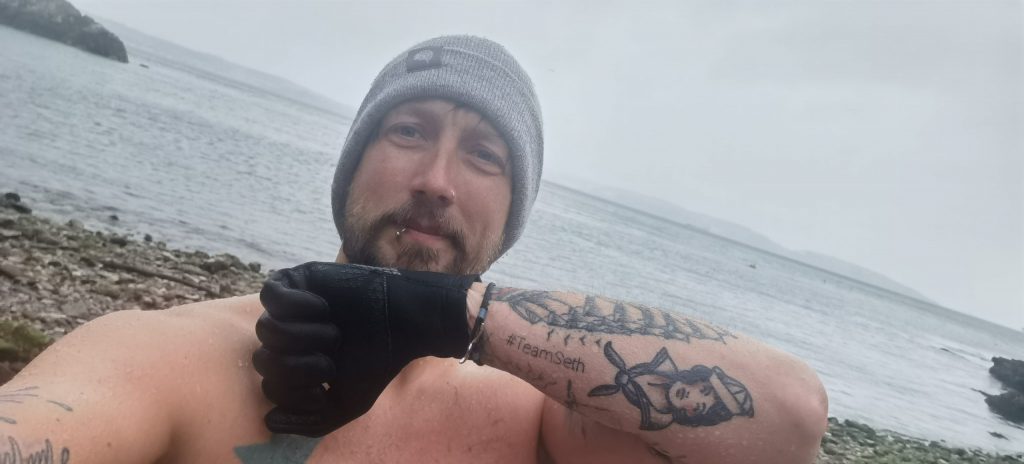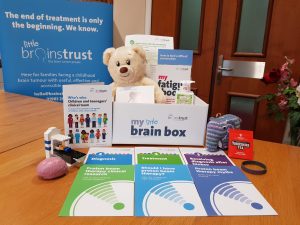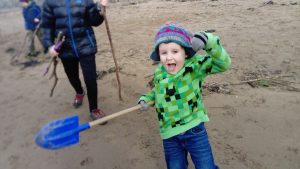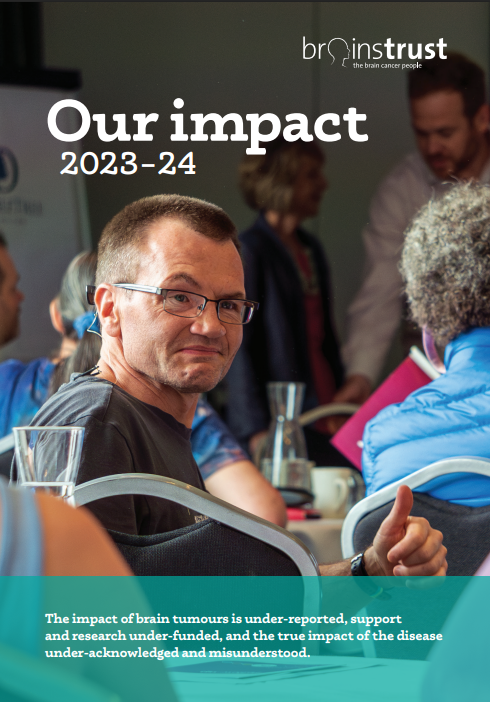A story of friendship
Determined and committed, Greg is taking to the seas in loving memory of Seth Dickenson. Greg met Seth’s parents, Sam and James, during brainstrust’s 2019 Follow the Seagulls trek.
Whilst conquering 50 miles over the challenge weekend, they had the pleasure of connecting. After chatting along the coastline from sunrise to sunset, they formed a close friendship that continues to this day. Sam said:
“We first met Greg on our Dartmouth Follow the Seagulls walk in 2019, just after Seth had successfully completed his first round of treatment. I remember spotting him on the bus to the start, with his long hair, beard and Gandalf style walking pole and thinking “ah he looks like someone we’d get on with!”
50 miles and a few beers later, we’d established that yes, we all shared a sense of humour and what really struck me was that, unlike us, Greg had no other reason to be supporting brainstrust other than sheer generosity of spirit. He wanted to do something local for a good cause and walking 50 brutal miles of the Devon coast path was it.
Now poor unsuspecting Greg was about to find out that he was going to become adopted by the Dickensons! I took the boys to visit him over the summer and a firm friendship sprang up.”
Inspiring a community
A the time, brave little Seth was just five years old and had undergone intensive treatment for his brain tumour. Having been supported by little brainstrust, we were all overjoyed to witness Seth ringing the ‘end of treatment’ bell. Sadly, in early 2020 the family received some devastating news – Seth’s cancer had returned. From that moment on, #TeamSeth gathered around the Dickenson’s to offer their support.
 Seth, his parents and his three older brothers inspired so many people to help raise vital funds in support of families affected by a brain tumour diagnosis. From virtual runs to quiz nights, the #TeamSeth community has gone above and beyond to raise thousands of pounds, all whilst making special memories to treasure forevermore. Greg has played a big role in this, and continues to show his support for the family’s chosen charity, brainstrust.
Seth, his parents and his three older brothers inspired so many people to help raise vital funds in support of families affected by a brain tumour diagnosis. From virtual runs to quiz nights, the #TeamSeth community has gone above and beyond to raise thousands of pounds, all whilst making special memories to treasure forevermore. Greg has played a big role in this, and continues to show his support for the family’s chosen charity, brainstrust.
“In May 2021 Seth’s fight sadly ended at the age of seven. He was a fighter and an amazing little human. Inspired by Seth, I’m now taking on another challenge of wild swimming for 365 consecutive days. No wet-suit, all weather’s and conditions. From the total raised over the next year 20% of donations will go to the 365 Legacy fund (funding local Torbay projects) and 80% to brainstrust who help support those affected by brain tumours.”
Remembering Seth
We recently spoke to Seth’s mum, Sam, about Greg’s 365 challenge. Sam shared a special memory, and explained how grateful she is to Greg for his friendship and support:
“I think my favourite story that Greg has told us is that playing catch with Seth down on the beach one afternoon, Seth said “Greg, I’m not very good at this game!”
“Why not Seth?” Greg asked.
“Well I’m blind in one eye aren’t I?” Seth replied matter of factly, properly putting Greg back in his place with a twinkle in his (good) eye!
And that was our boy all over. Despite everything, always laughing, always winning people’s hearts. Which is why when Greg mentioned to us about doing the 365 swim in Seth’s name, we felt not only honoured, that someone would take on this challenge in the name of our brave little warrior but also immensely grateful that through this act, our little boy will be talked about and remembered.”
Sam continued to share some touching words about Greg, and the heartfelt meaning behind his challenge:
“I think one of a parent’s greatest fears over losing a child, aside from the grief, is that their child, their world, will be forgotten or that people will be afraid to mention their name for fear of causing further hurt. But in fact, talking about Seth, sharing his story, his bravery and his absolute determination to live his life to the full helps us to feel that his short life wasn’t for nothing. We hope that his journey will inspire other people to keep going when times are tough and push people to achieve more than they think themselves capable of. Greg’s swim challenge is a part of this, his desire to support brainstrust in Seth’s memory, to keep that spark of determination alive means that other people will benefit indirectly from our son’s short life.
The beach was one of Seth’s favourite places and although health problems meant he wasn’t allowed to go in the sea for the last year of his life, he was never happier than beside the sea, so Greg’s challenge seems incredibly appropriate. After Seth’s funeral, we gathered on the beach and at least 20 people joined Greg in his swim for the day to mark Seth’s passing and celebrate his life. It was an incredibly moving moment as the swimmers joined together in a circle of friendship to remember Seth and his incredible zest for life.
As a family, we all love a swim but the thought of taking on a 365 wetsuit free swim challenge is a really bold one and we hope to support Greg as much as we can through the coming months, as a support to brainstrust but also as a huge thank you to a stranger who became a great friend to us all in our time of need. Thanks Greg, together we are all #teamseth!”
Making every day count


Every brain box is customised, and includes a selection of age appropriate resources, such as our young people’s radiotherapy book and who’s who guide to clinical teams. We also include some small gifts to help everyone practice the importance of self-care. Having raised over £500, Greg is already making an incredible difference and we couldn’t be more grateful for his continued support.











